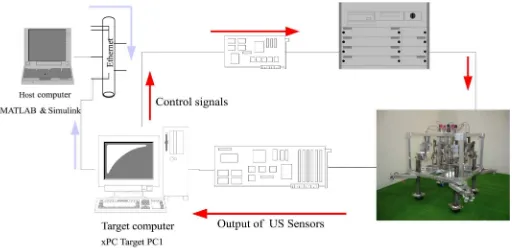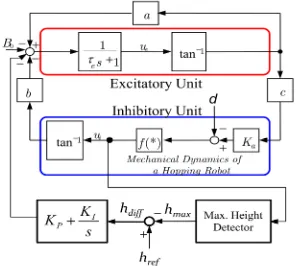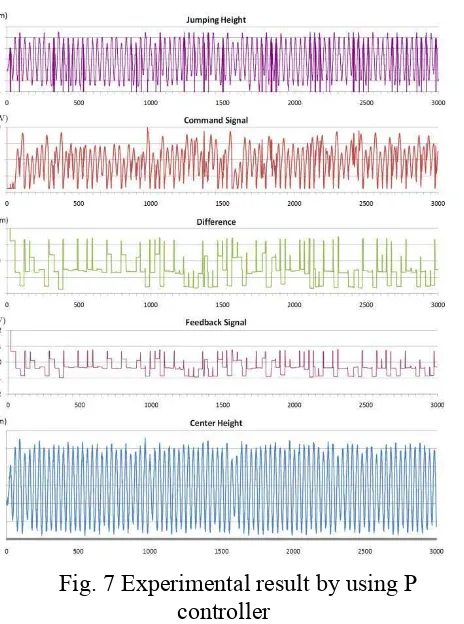Effect of Reference Height Control System on CPG Networks for
Keywords:Quadruped hopping robot, reference height control system, CPG networks
Abstract. In this paper, the collaboration of CPG networks with the feedback control system which are composed with the maximum hopping height detector and the Proportional Integral (PI) controller as an engineering application for the CPG network is proposed with the developed control systems. By adding the feedback loop through the feedback controller, the developed quadruped hopping robot not only can generate the continuous hopping performances but also can control the desired hopping height. As the result, the effectiveness of CPG networks to keep the stability of the developed quadruped hopping robot besides of confirming the validity of using reference height control system to generate hopping capability at different reference height, respectively.
Introduction
Physiological experiments suggest that basic locomotors patterns of most living bodies such as walking, flapping, flying and swimming are generated by central pattern generators (CPGs) which generate rhythmic activities [1]. CPG are neural networks that can endogenously (i.e. without rhythmic sensory or central input) produce rhythmic patterned outputs; these networks underlie the production of most rhythmic motor patterns. The first modern evidence that rhythmic motor patterns are centrally generated was the demonstration that the locust nervous system, when isolated from the animal, could produce rhythmic output resembling that observed during flight [2].
Furthermore, neurophysiologic studies of insect locomotion suggest that sensory feedback is involved in patterning motor activity and that it is more than the modulation of the centrally generated pattern. And as application of the CPG, a method of designing control systems for legged robot motion has been reported. On the basic of the definition, walking is locomotion emerging from that interaction between the environment and the body. Here, Taga proposed a walking motion control mode in which neural oscillator interact with the sensory feedback signals from the musculoskeletal systems [3].
Then, by using the concept of walking motion control model suggested by Taga, Kimura proposed a method of structuring the coupling of neural and mechanical systems for the implementation of autonomous adaption to irregular terrain [4]. Son et al. proposed a CPG model including the motor dynamic characteristics of an actuator for the purpose of implementing generation adaptive gait patterns for a quadruped robot under various environments [5]. Then, to apply in quadruped hopping robot, Kondo proposed the CPG network to generate continuous jumping motion patterns [6-8].
In this paper, the collaboration of CPG networks with the feedback control system which are composed with the maximum hopping height detector and the Proportional Integral (PI) controller as an engineering application for the CPG network is proposed with the developed control systems. By adding the feedback loop through the feedback controller, the developed quadruped hopping robot not only can generate the continuous hopping performances but also can control the desired hopping height.
Developed Quadruped Hopping Robot
Robot Construction. Figure 1 shows the developed quadruped hopping robot construction (overall length is 49cm, overall width is 49cm, overall height is 37cm and the total weight is 9.1kg). The quadruped hopping robot consists of the legs. Each leg is composed with a DC geared motor (12V, 200min-1, 0.0098Nm), a crank and a spring attached to the crankshaft. Then, each leg is connected to the shared platform. The developed quadruped hopping robot is developed by a DC geared motor which is driven by using DC amplifier and connect to the crank which used to push the platform.
As shown in Fig.2, the hopping mechanism of the quadruped hopping robot can be achieved respectively. Here, the motor torque is converted to the periodic force to the spring and make a periodical hopping motion of hopping robot as the basis of the principle hopping motion. The continuous hopping of quadruped hopping robot could be generated by using floor repulsive force when the suitable force was applied to the spring at the suitable time.
Fig. 1 Quadruped hopping robot Fig. 2 Hopping mechanism
Experimental Setup. Figure 3 shows the experimental setup to evaluate the quadruped hopping robot. The proposed CPG network is expressed using a MATLAB/Simulink model on a host computer. Then the model, built by a realtime workshop, is downloaded to xPC target computer. The xPC target computer is run by using a realtime OS. The position of the center and each leg are measured using ultrasonic sensors which are used as sensory feedback signals of the CPG. The sampling time is set for controlling this experimental setup is 0.01s.
Fig. 3 Experimental setup
System Configuration
where f(*) is the mechanical dynamics of the hopping robot’s leg, Kais the gain constant of the DC amplifier and d is the external disturbance which is the floor repulsive force in this case. By arbitrarily hanging the coupling parameters a, b, c, the time constant τe and the mechanical dynamics of the hopping robot, the CPG can change the amplitude and the frequency of internal states ueand ui.
Fig. 4 CPG model Fig. 5 Reference height control system
Proposed Control System. The architecture of the proposed control system for a leg is shown in Fig. 5. The control system is composed of the maximum height detector, the PI controller and the CPG. By adding a feedback loop through a fixed gain PI controller, quadruped hopping robot keep the hopping motion and controls the hopping height to achieve the desired hopping height. The proposed control system drive all the joint actuators of the legs in order to realize the desired hopping position generated by the PI controller, respectively. The PI feedback controller receives the command signal of the target hopping position as a reference href and also receives sensory feedback signals hmax from the ultrasonic sensors on each of the legs. Then, a modified target hopping position is generated from the nominal target hopping position through the mutual entertainment of the oscillators with the feedback signals of the ultrasonic sensors. The target hopping position generated is given to the PI controller as a command signal.
CPG Networks. The quadruped hopping robot can continuously jump by applying the same periodic force to each spring of robot and the cooperative oscillation among the CPGs is required. Figure 6 shows the configuration of typical CPG network. By using the ring-and-cross type CPG network, the stable, continuous and rhythmical hopping performance is obtained [6]. However, by using only this system, the developed quadruped hopping robot only can jump continuously but still cannot control the hopping height to the reference height position.
Fig. 6 Ring cross type CPG networks
Results and Analysis
Here, the figure for command signal shows the voltage which having an absolute value. In these figures, the position of ultrasonic sensors which are set at 13cm as initial position start from 0 and the oscillation of the spring which is shown as plus and minus means the spring are stretching or compressing. And the whole experiment is conducted in 30sec to evaluate the effectiveness of the proposed control system. Here, the reference hopping height which is given to each leg is 5cm and the CPG network coupling parameters which is used in this experiment are a = 0.1, b = 5, c = 1, B0 = 0.01, τe = 0.1, f = 0.1 and the P controller’s gains are set as KP = 5.5. From the experimental results, the hopping height which is obtained is approximately 6cm and the difference is approximately 1cm.
From these experimental results, by using only P controller, the difference (steady-state error) cannot be converged to zero and the target hopping height cannot be achieved. Therefore, the new controller system by using PI controller in order to control the command signal for achieving the target hopping height is proposed. In control engineering, a PI controller is a feedback controller which drives the plant to be controlled with a weighted sum of the error (difference between the ultrasonic sensor output and reference hopping height) and the integral of that value. The integral term in a PI controller can causes the steady-state error to be zero for a step input.
In order to compare with the system using P controller and evaluate the effectiveness for achieving target hopping height, the experiment using PI controller was carried out. Here, the reference hopping position and the CPG network coupling parameters is same with the experiment by using P controller and PI controller’s gain are set as KP = 5.5 and KI = 0.4. The experimental results using PI controller are shown in Fig.8. These figures are included the jumping height, command signal, difference, feedback signal and center jumping height for a leg which is CPG1 from the developed quadruped hopping robot. From the experimental results which using PI controller, the hopping height of the developed quadruped hopping robot are achieving the desired hopping height after 21sec is confirmed.
Fig. 7 Experimental result by using P controller
Fig. 8 Experimental result by using PI controller
sensory feedback from the ultrasonic sensors measures the current maximum hopping height and if the desired hopping positions are not achieved, there are more voltage will be given as the input voltage to generate higher hopping position by the DC geared motor. Even else, the current hopping height are over than desired hopping position, less voltage will be given to the DC geared motor to generate the stable hopping performance. Therefore, by using PI controller, the steady-state errors of hopping height is confirmed can be converge to zero at last. Otherwise, by using the proposed control system with the CPG network could make the stable hopping performances which shown at the center height in Fig.8.
Conclusions
In this paper, the CPG networks which act as a command centre for the musculoskeletal system and the proposed controller systems to generate the continuous hopping performances and to control the desired hopping position of the developed quadruped hopping robot is evaluated. By using the collaboration of CPG networks and the PI feedback controller, the successful hopping performance is obtained which the hopping height of the quadruped hopping robot is same with the desired hopping position while the continuous and the stabilization of hopping performances is achieved where the mechanical dynamics of each leg of the hopping robot generates periodic motion patterns.
In the future, more possibilities of quadruped hopping robot to achieve higher hopping height than the current achievement will be investigated. Then, the development of simulation model for the quadruped hopping robot by using learning algorithm will be done to search the parameters of CPG networks for hopping on an arbitrary place.
Acknowledgement
This research was supported by grant from Universiti Teknikal Malaysia Melaka award no. FRGS/2012/FKE /TK02/03/2/F00124 S726 and also technically support from Yasuno laboratory member, The University of Tokushima, Japan.
References
[1] Grillner S, Neurobiological bases of rhythmic motor acts invertebrates, Science, Vol.228, pp. 143-149, 1985.
[2] Marder E and Calabrese RL; Principles of rhythmic motor pattern production, Physiological Reviews, No. 76, pp 687-717, 1996.
[3] G. Taga, A model of the neuro-musculo-skeletel system for human locomotion 2. Realtime adaptability under various constraints, Biol. Cybernetics, No.73, pp. 113-121, 1995.
[4] H. Kimura, Dynamic walking on irregular terrain and running on flat terrain of the quadruped using neural oscillator, J. Robotics Soc. Jpn, Vol.16, No.8, pp. 1138-1145, 1998.
[5] Y. Son, T. Kamano, T. Yasuno, T. Suzuki, and H. Harada, Generation of adaptive gait patterns for quadruped robot with CPG networks including motor dynamic model, Electrical Eng. Jpn., Vol.115, No.1, pp. 35-43, 2006
[6] K. Kondo, T. Yasuno and H. Harada, Generation of jumping motion patterns for quadruped hopping robot using CPG network, Jou. of Signal Processing, Vol.11, No.11, pp. 321-324, 2007
[7] A.M. Kassim, N.H.A Rahim, M.F. Miskon, T.Yasuno “Moving Motion Control System On Developed Tripod Hopping Robot ”, Proceedings of International Conference on Electrical Control and Computer Engineering 2011,Kuantan, Malaysia,21-22 Jun 2011


